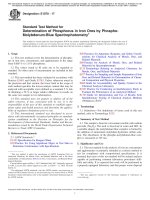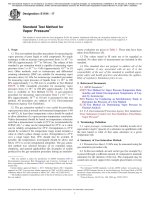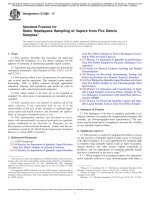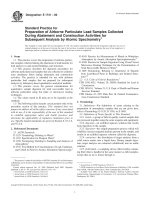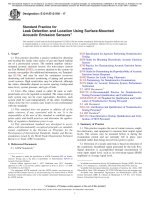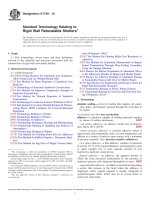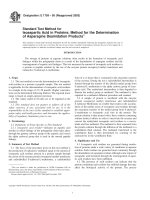Astm e 3078 17
Bạn đang xem bản rút gọn của tài liệu. Xem và tải ngay bản đầy đủ của tài liệu tại đây (228.3 KB, 7 trang )
This international standard was developed in accordance with internationally recognized principles on standardization established in the Decision on Principles for the
Development of International Standards, Guides and Recommendations issued by the World Trade Organization Technical Barriers to Trade (TBT) Committee.
Designation: E3078 − 17
Standard Practice for
Conditioning of Hard Armor Test Items1
This standard is issued under the fixed designation E3078; the number immediately following the designation indicates the year of
original adoption or, in the case of revision, the year of last revision. A number in parentheses indicates the year of last reapproval. A
superscript epsilon (´) indicates an editorial change since the last revision or reapproval.
the “other standards and specifications” and for specifying any
requirements that supersede those of this practice.
1. Scope
1.1 This practice applies to the conditioning of hard armor
test items prior to ballistic resistance testing. Hard armor is an
item of personal protective equipment that is constructed of
rigid materials and is intended to protect the wearer from
threats that may include ballistic threats, stabbing,
fragmentation, or blunt impact, or combinations thereof. (Terminology E3005.) Hard armor is also referred to as hard armor
plate and plate.
Note—Ballistic resistance testing is not covered in this
practice.
1.5 This practice does not address pass/fail requirements for
test items subjected to these procedures.
1.6 This practice does not address visual inspections or
radiographic inspections of test items that may be required
prior to or following conditioning.
Note—It is recommended that a thorough visual examination of each test item prior to and after the exposures be
performed to document any change in physical appearance
resulting from the exposure.
1.2 This practice describes requirements for subjecting test
items to conditions intended to assess the capability of the test
item to withstand environmental conditions that induce responses similar to those that might result from conditions
encountered during use. This practice includes the conditioning
procedures listed below:
(1) Controlled ambient conditioning procedure,
(2) Thermal/temperature shock procedure,
(3) Temperature extremes procedure,
(4) Weathering procedure,
(5) Fluid exposure procedure,
(6) Altitude exposure procedure,
(7) Vibration conditioning procedure,
(8) Impact Durability pre-conditioning,
(9) Impact Durability procedure for torso front and back
plates, and
(10) Impact Durability procedure for other plates (that is,
other than torso front and back plates).
1.7 This practice does not address subsequent conditioning
or testing of test items.
1.8 Units—The values stated in SI units are to be regarded
as standard. The values given in parentheses are mathematical
conversions to inch-pound units that are provided for information only and are not considered standard.
1.9 This standard does not purport to address all of the
safety concerns, if any, associated with its use. It is the
responsibility of the user of this standard to establish appropriate safety and health practices and determine the applicability of regulatory limitations prior to use.
2. Referenced Documents
2.1 ASTM Standards:2
D1141 Practice for the Preparation of Substitute Ocean
Water
D1776 Practice for Conditioning and Testing Textiles
E3005 Terminology for Body Armor
1.3 The user of this practice shall determine which conditioning procedures apply.
Note—This practice may not be applicable to all types of
hard armor.
2.2 AATCC Standard:3
AATCC TM 169 Weather Resistance of Textiles: Xenon
Lamp Exposures
1.4 In this practice, “other standards and specifications” and
“unless specified elsewhere” refer to documents (for example,
military standards, purchase specifications) that require the use
of this practice. Purchasers and other users are responsible for
2
For referenced ASTM standards, visit the ASTM website, www.astm.org, or
contact ASTM Customer Service at For Annual Book of ASTM
Standards volume information, refer to the standard’s Document Summary page on
the ASTM website.
3
Available from American Association of Textile Chemists and Colorists
(AATCC), P.O. Box 12215, Research Triangle Park, NC 27709-2215, http://
www.aatcc.org.
1
This practice is under the jurisdiction of ASTM Committee E54 on Homeland
Security Applications and is the direct responsibility of Subcommittee E54.04 on
Personal Protective Equipment (PPE).
Current edition approved Feb. 1, 2017. Published March 2017. DOI: 10.1520/
E3078-17.
Copyright © ASTM International, 100 Barr Harbor Drive, PO Box C700, West Conshohocken, PA 19428-2959. United States
1
E3078 − 17
2.3 Military Standard:4
MIL-STD-810G Test Method Standard for Environmental
Engineering Considerations and Laboratory Tests
8. Temperature Extremes Procedure
8.1 Tests shall be performed in accordance with constant
temperature exposure procedures of MIL-STD-810G, Method
501.5, Procedure I (high temperature) and Method 502.5,
Procedure I (low temperature).
3. Terminology
3.1 The terms and definitions of Terminology E3005 apply
for the following terms: ballistic resistance, conditioning, hard
armor plate, in conjunction with armor, shoot pack, soft armor,
strike face, and test item.
8.2 One set of test items shall be subjected to high
temperature, and another set shall be subjected to low temperature. Ramping of temperature is prohibited.
8.2.1 The starting temperature shall be controlled ambient.
8.2.2 One set of test items shall be heated in a chamber
operating at 71.1 6 3°C (155 6 5°F) for a minimum of 6 h, not
to exceed 7 h.
3.2 Definitions of Terms Specific to This Standard:
3.2.1 applique, n—for hard armor testing, backing material
intended to fill the space behind the test item during testing or
conditioning procedures.
3.2.2 controlled ambient, n—conditions with temperature of
20 6 5.5°C (68 6 10°F) and 50 6 20 % relative humidity
(RH). Within this practice, this definition applies to any direct
or indirect reference to controlled ambient.
9. Weathering Procedure
9.1 Weathering of test items shall be performed in accordance with AATCC Test Method 169 with the modifications
listed below:
(1) The test apparatus shall be equipped with an automatic
light monitor and shall be capable of automatically controlling
irradiance, temperature, and humidity.
(2) The test items shall be positioned with the strike face
toward the light source.
(3) The weathering cycle shall be a total of 180 min,
consisting of the following in order: 40 min of light, 20 min of
light with water spray on the test item, 60 min of light, and 60
min of darkness. The cycle shall be repeated until the total
energy exposure is equal to 100 kJ/m2, and the weathering
cycle shall be terminated at that point.
(4) The spectral irradiance level shall be 0.55 6 0.01
W/m2/nm bandpass at 340 nm.
(5) The temperatures and RH shall be as specified in Table
1.
4. Significance and Use
4.1 It is anticipated that this practice will be referenced by
certifiers, purchasers, and other users in order to meet their
specific needs. Those users will specify which conditioning
procedures are applicable.
5. Test Items
5.1 The test items are individual hard armor plates.
5.2 The quantity and size of test items to be conditioned and
other relevant test item details are specified in other standards
or specifications.
5.3 Unless otherwise specified, test items shall be stored in
controlled ambient conditions following conditioning procedures.
9.2 After the required exposure period, the test items shall
be removed from the apparatus.
6. Controlled Ambient Conditioning Procedure
10. Fluid Exposure Procedure
6.1 Test items shall be subjected to controlled ambient
conditions for at least 24 hours.
10.1 MIL-STD-810G, Procedure II, Method 504.1 and Procedure I, Method 512.5 shall be used with modifications as
described below:
(1) Test items shall be subjected to conditioning in fluids,
with each fluid at a temperature between 16 and 26°C (60 and
80°F).
(2) Each test item shall be subjected to only one fluid. The
type of fluid used shall be documented.
(3) Fluid conditioning equipment shall consist of a fluid
container of sufficient size to allow at least one test item of the
largest size to rest horizontally. Test items shall not be stacked
atop each other during conditioning but may be placed sideby-side.
7. Temperature Shock Procedure
7.1 Tests shall be performed in accordance with MIL-STD810G, Method 503.5, Procedure I-A, with the following
modifications:
7.1.1 The extreme temperatures shall be T1: –31.7 6 3°C
(–25 6 5°F) and T2: 48.9 6 3°C (120 6 5°F).
7.1.2 Test items shall be subjected to temperature conditioning steps as follows: (1) controlled ambient, (2) T1, (3) T2, and
(4) controlled ambient. Transfer of test items from one condition to another shall be accomplished in less than one minute.
Ramping of temperature is prohibited.
7.1.3 The test items shall be subjected to each specified
temperature for a minimum of 2 h, not to exceed 2 h and 15
min.
TABLE 1 Temperatures for Weathering Procedure
Black Panel
Relative Humidity
4
Available from U.S. Government Printing Office, Superintendent of
Documents, 732 N. Capitol St., NW, Washington, DC 20401-0001, http://
www.access.gpo.gov.
2
Dark Cycle
38 ± 3°C (100 ± 5°F)
$95 %
Light Cycle
77 ± 3°C (171 ± 5°F)
50 ± 5 %
(This does not apply to
light cycle with water
spray.)
E3078 − 17
(4) A “20-lb weight” shall be placed on each test item to
prevent floating while in fluid.
(5) Test items shall be conditioned in containers of fluid
using one of the methods described below:
(a) 30w lubricating oil of commercial grade SE or better.
The test item shall be placed strike face down in a container
that is then filled with enough fluid to cover the strike face. The
test item shall remain in the fluid for 2 h, not to exceed 2 h and
15 min.
Note—The test item is not required to be completely
submerged.
(b) 10w-40 lubricating oil of commercial grade SE or
better. The test item shall be weighed to the nearest 5 g (0.01
lb) prior to fluid conditioning. The test item shall be placed in
a container that is filled with enough fluid for the test item to
be completely immersed. The test item shall be immersed for
10 min, not to exceed 11 min. Following conditioning, the test
item shall be wiped clean and weighed to the nearest 5 g (0.01
lb).
Note—The test item is required to be completely submerged.
(c) Vehicle fuel. The test item shall be placed strike face
down in a container that is then filled with enough fluid to
cover the strike face. The test item shall remain in the fluid for
2 h, not to exceed 2 h and 15 min.
Note—Examples of vehicle fuels that may be used
include gasoline, diesel, F-24, and JP-8.
Note—The test item is not required to be completely
submerged.
(d) Vehicle fuel. The test item shall be weighed to the
nearest 5 g (0.01 lb) prior to fluid conditioning. The test item
shall be placed in a container that is filled with enough fluid for
the test item to be completely immersed. The test item shall be
immersed for 10 min, not to exceed 11 min. Following
conditioning, the test item shall be wiped clean and weighed to
the nearest 5 g (0.01 lb).
Note—The test item is required to be completely submerged.
(e) Salt water. The test item shall be placed in a container
that is filled with enough fluid for the test item to be completely
immersed. The salt water shall have a concentration of 4.6 %
sodium chloride (NaCl), and the test item shall be immersed
for 2 h, not to exceed 2 h and 15 min. An alternative to salt
water is Substitute Ocean Water, prepared in accordance with
Practice D1141.
Note—The test item is required to be completely submerged.
(f) Cleaner, Lubricant, and Preservative. The test item
shall be weighed to the nearest 5 g (0.01 lb) prior to fluid
conditioning. The test item shall be placed in a container that
is filled with enough fluid for the test item to be completely
immersed. The test item shall be immersed for 10 min, not to
exceed 11 min. Following conditioning, the test item shall be
wiped clean and weighed to the nearest 5 g (0.01 lb).
Note—The test item is required to be completely submerged.
10.2 Following each exposure in which the test item is not
required to be wiped clean, the test items shall be positioned
vertically to drip dry for at least 5 min.
Note—Other standards or specifications will give the time
interval between removal from the fluid and any subsequent
procedure.
11. Altitude Exposure Procedure
11.1 The test items shall be placed in an air pressure
chamber to simulate changes in altitude.
11.2 The change rate of the air pressure shall simulate a
change in altitude of 460 to 610 m/min (1500 to 2000 ft/min).
11.3 The temperature(s) in the chamber shall be specified by
the user of this practice.
11.4 The initial air pressure shall be zero gauge pressure.
11.5 The air pressure shall be decreased to 18.8 kPa or 2.73
PSIA (5.5 in. Hg) to simulate an ascent to 12 200 m (40 000 ft)
altitude and shall be maintained for 1 h 6 5 min.
11.6 The air pressure shall be increased to 57.2 kPa or 8.3
PSIA (16.9 in. Hg) to simulate a descent to 4600 m (15 000 m)
altitude and shall be maintained for 1 h 6 5 min.
11.7 The air pressure shall be changed to initial air pressure
and maintained for 30 6 5 min, and the test items shall be
removed from the chamber.
12. Vibration Conditioning Procedure
12.1 Tests shall be performed in accordance with MILSTD-810G, Method 514.6, Procedure II for Loose Cargo with
the following modifications:
(1) The test item shall be placed strike face down in a
wooden box. The box shall be rectangular having width and
length 25.4 to 38.1 mm (1.0 to 1.5 in.) larger than the
maximum width and maximum length of the test item. The box
shall have a lid attached to prevent the test item from flipping
over. The internal height of the box shall be approximately 89
mm (3.5 in.).
Note—The box has a bottom, sides, and a lid.
(2) The test item shall be positioned with the top and
bottom edges parallel to the x-axis.
(3) Vibration shall be caused by motion in the x and y plane
(that is, circular motion around the z-axis. Refer to Fig. 1 to
show positioning of test item in box (drawing not to scale; top
and front of box not shown).
(4) The wooden box shall be mounted to the vibration
table.
(5) The simulation of the loose cargo environment requires
the use of a vibration table that imparts a 25.4 6 2.5 mm (1.0
6 0.1 in.) peak-to-peak, circular synchronous motion to the
table at a frequency of 5 Hz 6 1.25 % for at least 1 h, not to
exceed 1 h and 15 min.
13. Impact Durability Pre-Conditioning
13.1 Laboratory Configuration and Test Equipment:
13.1.1 Environmental Chamber:
13.1.1.1 The environmental chamber shall have a controller
that maintains a set temperature to within 63°C (5°F) and that
maintains a set relative humidity to within 65 %.
3
E3078 − 17
FIG. 1 Positioning of Test Item in Box
13.1.1.2 The environmental chamber shall allow for the test
items to be positioned in the vertical orientation in which they
are intended to be used.
13.1.2 Environmental Chamber Monitoring Equipment:
13.1.2.1 The monitoring equipment shall include measurement and recording device(s), independent from the chamber
controllers.
13.1.2.2 The monitoring equipment shall provide and allow
documentation of temperature and relative humidity inside the
environmental chamber.
13.2 The pre-conditioning procedure is detailed below:
13.2.1 Place the test items into the environmental chamber
under controlled ambient conditions.
13.2.2 Set the environmental chamber for uniform thermal
exposure at a temperature of 65 6 2°C (149 6 3.6°F) and 80
6 5 % RH and ensure the change in conditions does not exceed
3°C/min (5°F/min) and 5 % RH per minute to avoid shocking
the test items.
13.2.3 Subject the test items to the specified conditions for
240 6 1 h.
FIG. 2 Decision Tree for Chamber Out-of-Tolerance Conditions
4
E3078 − 17
13.2.4 If an event occurs causing the chamber conditions to
go out of tolerance within the 240 h period, consult the
decision tree provided in Fig. 2.
13.2.5 Upon completion of the 240 h exposure, bring the
test items back to controlled ambient and ensure the change in
condition does not exceed 3°C (5°F) per minute and 5 % per
minute.
Note—When changing conditions, the humidity should be
reduced before the temperature to avoid creating a condensing
atmosphere inside the environmental chamber.
13.2.6 Remove the test items from the environmental chamber.
13.2.7 Perform a thorough visual examination of each test
item and document any change in physical appearance resulting from exposure.
13.2.8 Place the test items into an environmental chamber
preset to the initial conditions of Step 1 in Table 2.
13.2.9 Subject the test items to the conditions in Table 2.
Each step transition shall take place and stabilize in less than
30 min.
Note—Exposure time includes the stabilization time.
13.2.10 If an event occurs causing the chamber conditions
to go out of tolerance within the time period, consult the
decision tree provided in Fig. 2.
13.2.11 Upon completion of the 12-step exposure protocol
in Table 2, return the test items in the chamber to the initial
conditions of Step 1 in Table 2 at ramp rates listed in 13.2.2.
13.2.12 Remove the test items from the environmental
chamber.
13.2.13 Perform a thorough visual examination of each test
item and document any change in physical appearance resulting from exposure.
14.2.2 The following items shall be used with the impact
apparatus during testing:
14.2.2.1 Each test item is required to have an applique
between the wear face and the mounting plate. The applique
shall be Roma Plastilina No. 1®5 weighing 4.54 6 0.05 kg (10
6 0.1 lb). For in conjunction with armor6, the hard armor shall
be inserted into the appropriate soft armor or a shoot pack, and
the applique shall be positioned between the outside wear face
of the soft armor or shoot pack and the mounting plate.
Note—Additional details about the applique are provided in
other standards, specifications, and test methods.
14.2.2.2 A retention mechanism is required to hold the test
item with is applique securely in position in approximately the
center of the mounting plate. The retention mechanism may be
a strap, belt, band, or tape and shall be positioned to avoid
interference with the test item’s impact when dropped.
Note—The retention mechanism is not shown in Fig. 3.
14.2.2.3 The mounting plate and pivot arm (both shown in
the detailed drawings) and the retention mechanism shall have
a combined weight of 3.86 6 0.23 kg (8.5 6 0.5 lb).
14.2.2.4 The impact block shall be concrete, at least 46 by
46 cm (18 by 18 in.), with a thickness of at least 76 mm (3 in.)
and a flat, level surface. The impact block shall not move or
flex during impact.
Note—A concrete floor is an acceptable impact block.
14.2.2.5 A pivot point height adjustment shall be set so that
the pivot arm is horizontal in its stopping position and the test
item strikes the impact surface squarely as shown in Fig. 4.
14.2.2.6 The solid base provides a rigid support for the
attached components and shall either be weighted or solidly
affixed to the facility structure to prevent movement during the
procedure.
14. Impact Durability Conditioning Procedure for Torso
Front and Back Plates
14.3 Impact Procedure:
14.3.1 Perform durability pre-conditioning per Section 13.
14.3.2 Apply the backing material applique to the wear face
of the test item:
14.3.2.1 If the test item is intended to be stand-alone, the
applique shall allow the test item to be positioned against the
mounting plate surface with no obvious air gaps.
14.3.2.2 If the test item is part of an in conjunction with
armor6, the test item shall be backed by the applicable soft
armor panel in addition to the applique.
14.3.3 Align the centers of the applique and the test item
with the center of the mounting plate, and affix the applique
and test item to the mounting plate using the retention
mechanism.
14.3.4 To ensure correct positioning at impact, gently lower
the test item until it rests on the impact block and adjust the
pivot point height so that the pivot arm is horizontal.
14.3.5 Return the pivot arm to the vertical position. Release
the pivot arm allowing the test item to drop and hit the impact
surface. Perform this step a second time.
14.3.6 Remove the test item from the impact apparatus.
14.1 The purpose of this procedure is to subject hard armor
test items to durability conditioning including temperature,
humidity, and impact.
14.2 Impact Apparatus:
14.2.1 Detailed drawings of the impact apparatus are provided on www.astm.org, and the impact apparatus shall be
constructed according to those detailed drawings. Fig. 3
provides an illustration of how the impact apparatus may look.
TABLE 2 Exposure Condnitions
Steps
1
2
3
4
5
6
7
8
9
10
11
12
Time (hours)
(±5 minutes)
2
2
2
2
2
2
2
2
2
2
2
2
Temperature (°C)
(±2°C (±3.6°F))
25°C (77°F)
15°C (59°F)
5°C (41°F)
–5°C (23°F)
–15°C (5°F)
0°C (32°F)
15°C (59°F)
30°C (86°F)
45°C (113°F)
60°C (140°F)
75°C (167°F)
90°C (194°F)
Relative Humidity (%)
50 ± 5 %
N/A
N/A
N/A
N/A
N/A
N/A
50 ± 5 %
50 ± 5 %
50 ± 5 %
50 ± 5 %
50 ± 5 %
5
U.S. Government standards require ROMA Plastilina No. 1®, from Sculpture
House, Inc., as the backing material for ballistic-resistance testing.
6
In conjunction with armor is defined in Terminology E3005.
5
E3078 − 17
FIG. 3 Impact Apparatus – Starting Position
FIG. 4 Impact Apparatus – Final Position
Note—A concrete floor is an acceptable impact block.
15.2.2 The drop height shall be 122 6 1.3 cm (48.0 6 0.5
in.), measured from the test item strike face to the impact block
surface.
15.2.3 The test item shall be positioned such that the strike
face is parallel to the impact surface and the impact occurs as
near as possible to the center of the test item strike face (that
is, not near an edge).
15. Impact Durability Procedure for Other Plates (that
is, Other than Torso Front and Back Plates)
15.1 Perform durability pre-conditioning per Section 13.
15.2 The test item shall be dropped unhindered from the
specified height below onto an impact block.
15.2.1 The impact block shall be concrete, at least 45.8 cm2
(18 by 18 in.), with a thickness of at least 76.2 mm (3.0 in.) and
a flat, level surface. The impact block shall not move or flex
during impact.
15.3 Drop the test item two times.
6
E3078 − 17
16. Reporting of Results
17. Keywords
16.1 Steps, observations, interruptions, and other details of
conditioning shall be documented.
17.1 ballistic resistance; conditioning; hard armor; hard
armor plate
ASTM International takes no position respecting the validity of any patent rights asserted in connection with any item mentioned
in this standard. Users of this standard are expressly advised that determination of the validity of any such patent rights, and the risk
of infringement of such rights, are entirely their own responsibility.
This standard is subject to revision at any time by the responsible technical committee and must be reviewed every five years and
if not revised, either reapproved or withdrawn. Your comments are invited either for revision of this standard or for additional standards
and should be addressed to ASTM International Headquarters. Your comments will receive careful consideration at a meeting of the
responsible technical committee, which you may attend. If you feel that your comments have not received a fair hearing you should
make your views known to the ASTM Committee on Standards, at the address shown below.
This standard is copyrighted by ASTM International, 100 Barr Harbor Drive, PO Box C700, West Conshohocken, PA 19428-2959,
United States. Individual reprints (single or multiple copies) of this standard may be obtained by contacting ASTM at the above
address or at 610-832-9585 (phone), 610-832-9555 (fax), or (e-mail); or through the ASTM website
(www.astm.org). Permission rights to photocopy the standard may also be secured from the Copyright Clearance Center, 222
Rosewood Drive, Danvers, MA 01923, Tel: (978) 646-2600; />
7
